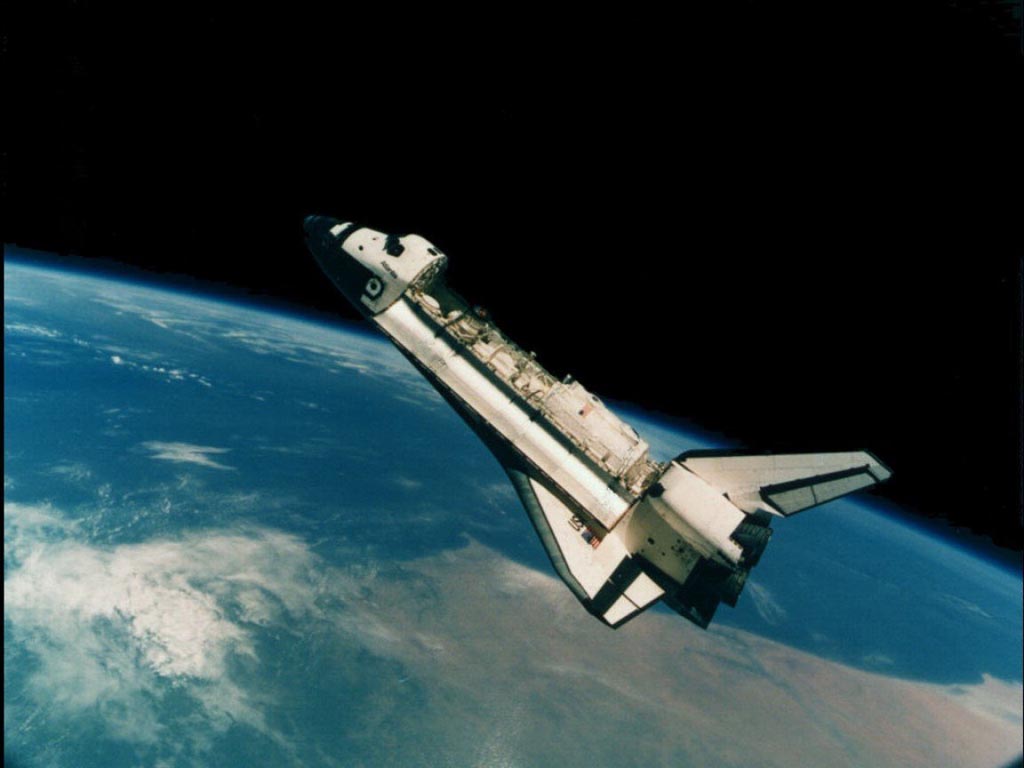Space Shuttle: Landing by gliding
January 5th, 2010 at 10:06 pm (Engineering, Spacecraft)
Tonight I was lucky enough to get to watch the International Space Station fly by: a bright unwinking point arcing upward and then, just past zenith, disappearing as it passed into the Earth’s shadow. This sight somehow never fails to stir something inside me. It is one thing to read news articles about spacecraft in orbit, and quite another to see them with your own eyes. Beyond that, the ISS marks our ability specifically to maintain a human presence in space—quite a bold and amazing feat, no matter how many years have passed since the Apollo missions.
 One way that we get humans (and equipment, supplies, etc.) from the ground and up to the ISS is via the Space Shuttle. The Shuttle is a marvel of engineering—perhaps too much of a marvel, rendering it less reliable than we might hope—and it is in the sunset of its career. 2010 will see the final Shuttle flights (just five more are planned), and then the Shuttle will be retired while effort and funds are focused instead on developing its successor, the Orion spacecraft. During the 5+-year gap between the Shuttle’s retirement and the first crewed Orion flights, we will rely on the Russian Soyuz spacecraft to reach and resupply the ISS.
One way that we get humans (and equipment, supplies, etc.) from the ground and up to the ISS is via the Space Shuttle. The Shuttle is a marvel of engineering—perhaps too much of a marvel, rendering it less reliable than we might hope—and it is in the sunset of its career. 2010 will see the final Shuttle flights (just five more are planned), and then the Shuttle will be retired while effort and funds are focused instead on developing its successor, the Orion spacecraft. During the 5+-year gap between the Shuttle’s retirement and the first crewed Orion flights, we will rely on the Russian Soyuz spacecraft to reach and resupply the ISS.
There are many fascinating engineering details about the Shuttle and how it works. I recently came across one that really surprised me. It turns out that when the Shuttle de-orbits and descends through the Earth’s atmosphere to land, it manages that whole long glide and deceleration without any engine power. Effectively, it aerobrakes (taking advantage of our thick atmosphere), and attitude control is maintained through thrusters and hydraulically actuated surfaces. This isn’t enough to slow it all the way down, so the Shuttle also executes several S-shaped swoops to the left and right, dissipating speed horizontally instead of vertically.
You can watch a Shuttle landing from the cockpit view (STS-98): fascinating, although I guess the video starts after the four swooping banks have already been done. The dramatic right turn you see in the video is the commander’s final lineup with the runway—a final turn that also reduces speed and altitude.
The next shuttle to launch will be Endeavor (STS-130), on February 7. It will be the 32nd shuttle mission to the ISS.
Jeff said,
January 6, 2010 at 7:05 pm
Y’know, I never understood what the point of having somebody called “pilot” was, when the captain gets to do the in-space docking bits.
Now I do. Wow.
Jim in PA said,
January 7, 2010 at 7:31 am
Jeff … didn’t you ever see SpaceCamp? Whenever the shuttle gets inadvertently launched into space by an emotionally attached robot, the pilot is the one who is expected to recover the shuttle from a 3-axis spin on reentry. Everyone knows that. :-)